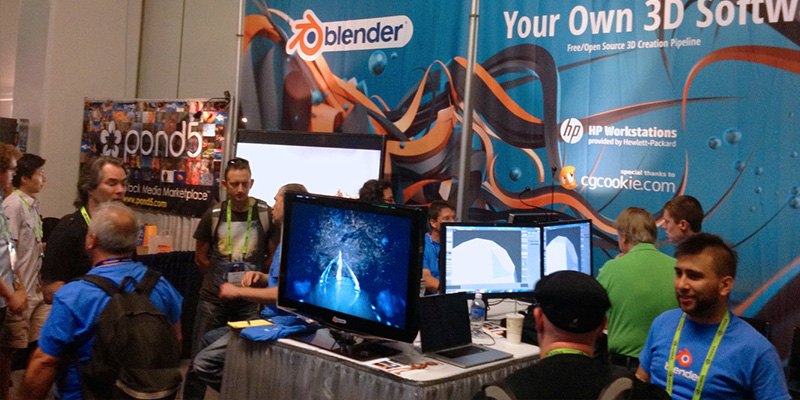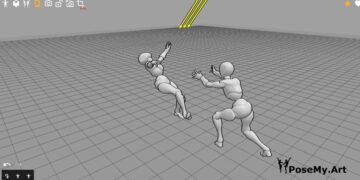The history of Blender 3D can be easily described as one of a kind, since it’s one of the best 3D software today but it wasn’t always the case. Because it went through an interesting journey like no other, and the least we can say about it is that it was long and difficult since it almost died at some point in its path of what it became today. The journey was filled with successes and failures but it is the thing that took it from nothingness to greatness. This is the story of Blender.
The history of Blender 3D is one to look up to
It all started with the story of an ambitious young man called Ton Roosendaal. He originally wanted to be an architect, but he later studied industrial design because he wanted to do something creative and technical in the same time. Ton was a talented man with many different skills who had a passion for computer graphics. So he decided to start a company and build the financial base to buy better and more reliable computers. The ultimate goal was to work as a full-time computer graphics designer, and to do 3D animation.

In 1988, when he was 29 years old Ton Roosendaal co-founded the Dutch animation studio called NeoGeo. A lot of people refer to it as the very first pillar in the history of Blender 3D as we know it today.
On the other side of the world in Japan, Neo Geo was also known as a family of video game hardware consoles developed by SNK. It was actually on the market from 1990 to 2004 so basically Ton Roosendaal company was the first that had the name.
Neo-Geo started in a studio in Eindhoven in the Netherlands, they launched the studio with a business partner and they got 7 employees doing computer graphics work.
The real work for Neo Geo started in 1991 when they bought their first big silicon graphics computer which was capable of doing real-time wireframe and solids. This computer cost them about $60,000 which was a big portion of their profits at the time. However, it was worth it since working on the amiga wasn’t a good choice for their projects, especially because they had to render the wireframe (which was very time-consuming).

NeoGeo quickly became the largest 3D animation studio in the Netherlands and one of the leading animation houses in Europe. NeoGeo created award-winning productions for large corporate clients such as the multinational electronics company Philips. And they were awarded the European Corporate Video Awards of 1993 and 1995.
Within NeoGeo, Ton was responsible for both art direction and internal software development. After a careful deliberation, Ton decided that the current in-house 3D toolset for NeoGeo was too old and cumbersome to maintain, and needed to be rewritten from scratch. So in 1995, this rewrite began and was the first chapter in the history of Blender 3D as we know it today.
Ton Roosendaal embarked on the journey of making his own 3D software step by step, and he was learning new things and having fun throughout the process of trial and error. However, he wanted to be different and not exactly like the 3D software available on the market at the time (like Softimage and 3DS Max). As a result, the first version of Blender was published in 1998.
First, it was only compatible with silicon graphics operating system called “Irix”. A few months later they had a Linux version, FreeBSD version, and later on, Roosendaal hired an employee to work on the windows version.

As NeoGeo continued to refine and improve Blender, it became apparent to Ton that it could be used as a tool for other artists outside of NeoGeo.
Later, Ton decided to sell Neo Geo because it was financially difficult to stay in the business of visualization and graphic design. Not to mention the other markets that were emerging, especially with the explosion of internet businesses.
The era of the NaN spin-off company
In 1998, Ton decided to create a new company called Not a Number (or NaN) as a spin-off of NeoGeo to further market and develop Blender. At the core of NaN was a desire to create and distribute a compact, cross-platform 3D application for free. It was free but there were some locked features that you had to pay for. So basically the company at the time sold keys to unlock more features, for $50 or $100 it was possible to unlock advanced features in Blender. In other words, the freemium model served the history of Blender 3D in its early stages.
At the time, this was a revolutionary concept as most commercial 3D applications cost thousands of dollars. The NaN hoped to bring professional-level 3D modeling and animation tools within the reach of the general computing public. There’s no doubt that it’s one of the visions that made the history of Blender 3D so one of its kind. So basically NaN’s business model involved providing commercial products and services around Blender.
In 1999 NaN attended its first SIGGRAPH conference in an effort to more widely promote Blender. Blender’s first SIGGRAPH convention was a huge success and gathered a tremendous amount of interest from both the press and attendees. Blender was a hit and its huge potential was confirmed!
Following the success of the SIGGRAPH conference in early 2000, NaN secured financing of €4.5M from venture capitalists. This large inflow of cash enabled NaN to rapidly expand its operations. Soon NaN boasted as many as 50 employees working around the world trying to improve and promote Blender. But the money that investors paid to the NaN was spent so fast on conferences, and business meetings, flying business class and so on. Which means that the company was burning through the money of the investors so fast.

In the summer of 2000, the history of Blender 3D marked a new milestone by releasing the version 2.0 packed with new features. This version of Blender added the integration of a game engine to the 3D application.
By the end of 2000, the number of users registered on the NaN website exceeded 250,000.
Unfortunately, NaN’s ambitions and opportunities did not match the company’s capabilities and the market realities of the time.
This over-extension resulted in restarting NaN with new investor funding and a smaller company in April 2001. Six months later NaN’s first commercial software product, Blender Publisher was launched. This product was targeted at the emerging market of interactive web-based 3D media. And due to disappointing sales and the ongoing difficult economic climate, the investors called Ton Roosendaal and told him that they are losing too much money investing in his company so they had to exit within 9 months especially with the dot com bubble and burst that happened around that time.

So the new investors decided to shut down all NaN operations. The shutdown also included discontinuing the development of Blender. Although there were clearly shortcomings in that version of Blender, such as a complex internal software architecture, unfinished features and a non-standard way of providing the GUI, the enthusiastic support from the user community and customers who had purchased Blender Publisher in the past, meant that Ton could not justify leaving Blender to fade into insignificance.
When Ton was approached by investors he owned %100 of Blender but after all of this happened he ended up with only %10. Which put him in a difficult situation that was not easy to get out of because he had to do a lot of convincing.
Since restarting a company with a sufficiently large team of developers was not feasible, Ton Roosendaal founded the non-profit organization, called Blender Foundation, in March 2002.
Blender Foundation: flipping the switch of the old business model
The Blender Foundation’s primary goal was to find a way to continue developing and promoting Blender as a community-based open source project. And In July 2002, Ton managed to get the NaN investors to agree to a unique Blender Foundation plan to attempt to release Blender as open source program. The “Free Blender” campaign sought to raise €100,000 so that the Foundation could buy the rights to the Blender source code and intellectual property rights from the NaN investors and subsequently release Blender to the open-source community.
With an enthusiastic group of volunteers, among them several ex-NaN employees, a fundraising campaign was launched to “Free Blender”. To everyone’s surprise and delight the campaign reached the €100,000 goal in only seven short weeks. On Sunday, October 13, 2002, Blender was released to the world under the terms of the GNU GPL.

With Blender originating as an in-house creation tool, the day-to-day feedback and interaction of both developing and using the software was one of its most outstanding features. In the first 2.5 years of open source development, it was especially this uniqueness of Blender that has proven to be difficult to organize and maintain.
The Blender Foundation decided to start a project to bring together the most outstanding artists in the Blender community and challenge them to make an exciting 3D animation short film.
This is how “Project Orange” started in 2005, which resulted in the world’s first and widely recognized Open Movie “Elephants Dream”. Not only was the entirely created using Open Source tools, the end-result and all of the assets that were used in the studio were published under an open license, the Creative Commons Attribute.
Ton Roosendaal established the “Blender Institute” in summer of 2007. This now is the permanent office and studio to more efficiently organize the Blender Foundation goals, but especially to coordinate and facilitate Open Projects related to 3D movies, games or visual effects.
In April 2008 the Peach Project, the open movie “Big Buck Bunny”, was completed in the Blender Institute. And In September 2008 the open game “YoFrankie!” was released. In September 2010 the short film “Sintel” premiered at the Netherlands Film Festival with a sold out screening in a 450 seat theater.

Early 2008 was also the start of the Blender 2.5 project, a major overhaul of the UI, tool definitions, data access system, event handling, and animation system. In other words: a major shift in the history of Blender 3D. The main target was to re-implement the core of Blender, originally developed mid 90ies, to bring it up to contemporary interface standards and input methods.
A first alpha version of Blender 2.5 was presented on Siggraph 2009. The online team of developers has since then focused on bringing back all 2.4 functionality and finishing the new design according to specifications. A final release of 2.5 has being published in 2011.
In 2012 the focus was put on further developing and exploring a Visual Effect creation pipeline. Topics that were tackled included motion tracking, camera solving, masking, grading and good color pipeline. A lot of these efforts were the foundation of current contributions, such as motion graphics addons and camera addons. Blender Institute’s fifth Open Project – the short film Tears of Steel – contributed a lot to this.
In 2014, a “Caminandes” (which is an independently produced series of computer-animated short films) was produced and released by the Blender Foundation. The film won the 2014 Jerry Goldsmith award for “Best Score for an Animated Short Film” at the International Film Music Festival in Spain. In this year, Blender improved a little bit further with support for volume rendering and small improvements to the user interface. In addition to Support for baking in Cycles and a strong basis for many awesome Blender addons for rendering.

In 2015, Blender development team added a lot of new features especially to Cycles which made it a lot better. And that was apparent in the Blender Institute’s 5th “open movie” project called cosmos laundromat. At SIGGRAPH 2015, various people from Pixar, Walt Disney Animation Studios, DreamWorks, Industrial Light & Magic, and Sony Imageworks praised the film for the storytelling, the character animations, and the visuals. You can check the list of awesome short films made with Blender if you want detailed information on the topic.
In 2017, a bunch of useful features were added to Blender which helped the animation team to work on the Blender institute short film called agent 327. The Blender Institute seeked additional funding to kickstart the production in the Netherlands of a high-end 3D animated agent 327 CG feature film.
The history of Blender 3D inspired passionate artists
2019 was a very important year in the history of Blender 3D because it was the year when Blender 2.8 was released. This version of Blender was and still is a pivotal point in the journey of Blender because it had a completely Revamped UI, with an additional dark theme, EEVEE real-time rendering engine on OpenGL, more advanced Grease Pencil 2D animation tool, collections, and much more.

Blender 2.8 attracted a large number of new 3D artists (you can check our “Top 50 List” if you want to be amazed!) whether they are beginners or professionals. But most importantly, it attracted companies such as AMD and Ubisoft that are willing to invest in further development of Blender.































